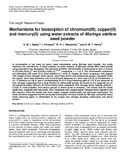| dc.contributor.author | Sajidu, S.M.I. | |
| dc.contributor.author | Persson, I. | |
| dc.contributor.author | Masamba, W.R.L. | |
| dc.contributor.author | Henry, E.M.T. | |
| dc.date.accessioned | 2014-02-13T12:20:51Z | |
| dc.date.available | 2014-02-13T12:20:51Z | |
| dc.date.issued | 2008 | |
| dc.identifier.citation | Sajidu, S.M.I. et. al (2008) Mechanisms for biosorption of chromium(III), copper(II) and mercury(II) using water extracts of Moringa oliefera seed powder, African Journal of Biotechnology Vol. 7, No. 6, pp. 800-804 | en_US |
| dc.identifier.issn | 1684–5315 | |
| dc.identifier.uri | http://hdl.handle.net/10311/1198 | |
| dc.description | Symbols on the abstract field may differ with the one's on the original paper. | en_US |
| dc.description.abstract | In continuation of our work on heavy metal remediation using Moringa seed powder, this study examines the mechanisms of metal sorption on water extracts of Moringa oleifera (MO) seed powder using extended X-ray absorption fine structure (EXAFS). Chromium(III) is hydrolysed to form a mixture
of [Cr3(OH)4(H2O)10]5+ and [Cr(OHx)2<(OH)2>]n n (2x-3)+ complexes, x = 1 or 2. The chromium(III) complexes are octahedral with mean Cr-O bond distance of 1.97(2) Å. Copper (II) forms complexes with ligands with oxygen and/or nitrogen donor atoms, most likely amino and carboxylate groups. Copper(II) retain the typical Jahn-Teller distortion with Cu-O/N bond distances of 1.97(2) and 2.21(4) Å. Furthermore, a Cu...C distance at 2.96 Å, and a corresponding Cu-O-C 3-leg scattering path at 3.10 Å are observed as well, strongly supporting that a large fraction of carboxylate groups are bound to the copper(II) ion on the equatorial plane. Mercury (II) forms mainly linear complexes with nitrogen donor ligands, d(Hg-N) =2.15(2) Å, most probably from amino groups in amino acids or proteins. This shows that the softer metal ions, copper(II) and mercury(II), form complexes with oxygen and/or nitrogen donor ligands in the MO extracts, while the harder and more highly charged chromium(III) ion becomes hydrolysed. The study therefore suggests that the successful biosorption of heavy metals by Moringa, a potential heavy metal removing agent, is attributable to its oxygen and nitrogen donating carboxylate and amino groups. | en_US |
| dc.language.iso | en | en_US |
| dc.publisher | Academic Journals, http://www.academicjournals.org/AJB | en_US |
| dc.rights | Item available under Creative Commons Attribution License | en_US |
| dc.subject | Chromium | en_US |
| dc.subject | Copper | en_US |
| dc.subject | Mercury | en_US |
| dc.subject | Moringa oleifera | en_US |
| dc.subject | EXAFS | en_US |
| dc.title | Mechanisms for biosorption of chromium(III), copper(II) and mercury(II) using water extracts of Moringa oliefera seed powder | en_US |
| dc.type | Published Article | en_US |
| dc.link | http://www.academicjournals.org/AJB/PDF/pdf2008/18Mar/Sajidu%20et%20al.pdf | en_US |

